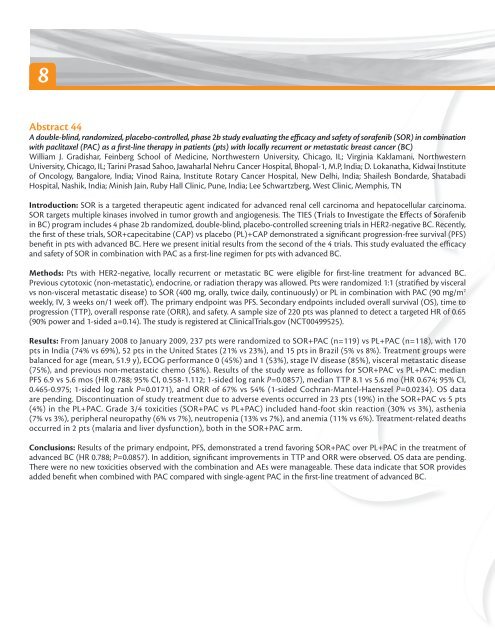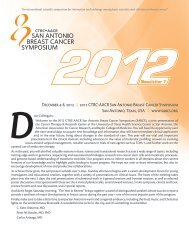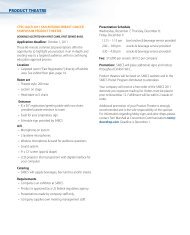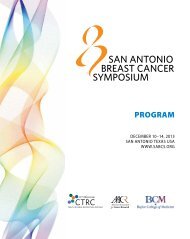Issue 1 - San Antonio Breast Cancer Symposium
Issue 1 - San Antonio Breast Cancer Symposium
Issue 1 - San Antonio Breast Cancer Symposium
You also want an ePaper? Increase the reach of your titles
YUMPU automatically turns print PDFs into web optimized ePapers that Google loves.
8<br />
Abstract 44<br />
A double-blind, randomized, placebo-controlled, phase 2b study evaluating the efficacy and safety of sorafenib (SOR) in combination<br />
with paclitaxel (PAC) as a first-line therapy in patients (pts) with locally recurrent or metastatic breast cancer (BC)<br />
William J. Gradishar, Feinberg School of Medicine, Northwestern University, Chicago, IL; Virginia Kaklamani, Northwestern<br />
University, Chicago, IL; Tarini Prasad Sahoo, Jawaharlal Nehru <strong>Cancer</strong> Hospital, Bhopal-1, M.P, India; D. Lokanatha, Kidwai Institute<br />
of Oncology, Bangalore, India; Vinod Raina, Institute Rotary <strong>Cancer</strong> Hospital, New Delhi, India; Shailesh Bondarde, Shatabadi<br />
Hospital, Nashik, India; Minish Jain, Ruby Hall Clinic, Pune, India; Lee Schwartzberg, West Clinic, Memphis, TN<br />
Introduction: SOR is a targeted therapeutic agent indicated for advanced renal cell carcinoma and hepatocellular carcinoma.<br />
SOR targets multiple kinases involved in tumor growth and angiogenesis. The TIES (Trials to Investigate the Effects of Sorafenib<br />
in BC) program includes 4 phase 2b randomized, double-blind, placebo-controlled screening trials in HER2-negative BC. Recently,<br />
the first of these trials, SOR+capecitabine (CAP) vs placebo (PL)+CAP demonstrated a significant progression-free survival (PFS)<br />
benefit in pts with advanced BC. Here we present initial results from the second of the 4 trials. This study evaluated the efficacy<br />
and safety of SOR in combination with PAC as a first-line regimen for pts with advanced BC.<br />
Methods: Pts with HER2-negative, locally recurrent or metastatic BC were eligible for first-line treatment for advanced BC.<br />
Previous cytotoxic (non-metastatic), endocrine, or radiation therapy was allowed. Pts were randomized 1:1 (stratified by visceral<br />
vs non-visceral metastatic disease) to SOR (400 mg, orally, twice daily, continuously) or PL in combination with PAC (90 mg/m 2<br />
weekly, IV, 3 weeks on/1 week off). The primary endpoint was PFS. Secondary endpoints included overall survival (OS), time to<br />
progression (TTP), overall response rate (ORR), and safety. A sample size of 220 pts was planned to detect a targeted HR of 0.65<br />
(90% power and 1-sided a=0.14). The study is registered at ClinicalTrials.gov (NCT00499525).<br />
Results: From January 2008 to January 2009, 237 pts were randomized to SOR+PAC (n=119) vs PL+PAC (n=118), with 170<br />
pts in India (74% vs 69%), 52 pts in the United States (21% vs 23%), and 15 pts in Brazil (5% vs 8%). Treatment groups were<br />
balanced for age (mean, 51.9 y), ECOG performance 0 (45%) and 1 (53%), stage IV disease (85%), visceral metastatic disease<br />
(75%), and previous non-metastatic chemo (58%). Results of the study were as follows for SOR+PAC vs PL+PAC: median<br />
PFS 6.9 vs 5.6 mos (HR 0.788; 95% CI, 0.558-1.112; 1-sided log rank P=0.0857), median TTP 8.1 vs 5.6 mo (HR 0.674; 95% CI,<br />
0.465-0.975; 1-sided log rank P=0.0171), and ORR of 67% vs 54% (1-sided Cochran-Mantel-Haenszel P=0.0234). OS data<br />
are pending. Discontinuation of study treatment due to adverse events occurred in 23 pts (19%) in the SOR+PAC vs 5 pts<br />
(4%) in the PL+PAC. Grade 3/4 toxicities (SOR+PAC vs PL+PAC) included hand-foot skin reaction (30% vs 3%), asthenia<br />
(7% vs 3%), peripheral neuropathy (6% vs 7%), neutropenia (13% vs 7%), and anemia (11% vs 6%). Treatment-related deaths<br />
occurred in 2 pts (malaria and liver dysfunction), both in the SOR+PAC arm.<br />
Conclusions: Results of the primary endpoint, PFS, demonstrated a trend favoring SOR+PAC over PL+PAC in the treatment of<br />
advanced BC (HR 0.788; P=0.0857). In addition, significant improvements in TTP and ORR were observed. OS data are pending.<br />
There were no new toxicities observed with the combination and AEs were manageable. These data indicate that SOR provides<br />
added benefit when combined with PAC compared with single-agent PAC in the first-line treatment of advanced BC.











